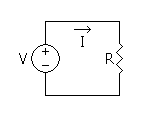- Ohm's law states that, in an electrical circuit, the current passing through a conductor between two points is directly proportional to the potential difference (i.e. voltage drop or voltage) across the two points, and inversely proportional to the resistance between them.
The mathematical equation that describes this relationship is:
I=V/R
- where I is the current in amperes, V is the potential difference between two points of interest in volts, and R is a circuit parameter, measured in ohms (which is equivalent to volts per ampere), and is called the resistance. The potential difference is also known as the voltage drop, and is sometimes denoted by U, E or emf (electromotive force) instead of V.[1]
The law was named after the physicist Georg Ohm, who, in a treatise published in 1827, described measurements of applied voltage, and current passing through, simple electrical circuits containing various lengths of wire, and presented a slightly more complex equation than the one above to explain his experimental results. The above equation is the modern form of Ohm's law; it could not exist until the ohm itself was defined (1861, 1864). Well before Georg Ohm's work, Henry Cavendish found experimentally (January 1781) that current varies in direct proportion to applied voltage, but he did not communicate his results to other scientists at the time.[2]
The resistance of most resistive devices (resistors) is constant over a large range of values of current and voltage. When a resistor is used under these conditions, the resistor is referred to as an ohmic device because a single value for the resistance suffices to describe the resistive behavior of the device over the range. When sufficiently high voltages are applied to a resistor, forcing a high current to flow through it, the device is no longer ohmic because its resistance, when measured under such electrically stressed conditions, is different (typically greater) from the value measured under standard conditions (see temperature effects, below).
Ohm's law, in the form above, is an extremely useful equation in the field of electrical/electronic engineering because it describes how voltage, current and resisitance are interrelated on a macroscopic level, that is, commonly, as circuit elements in an electrical circuit. Physicists who study the electrical properties of matter at the microsopic level use a closely related and more general vector equation, sometimes also referred to as Ohm's law, having variables that are closely related to the I, V and R scalar variables of Ohm's law, but are each functions of position within the conductor.


No comments:
Post a Comment